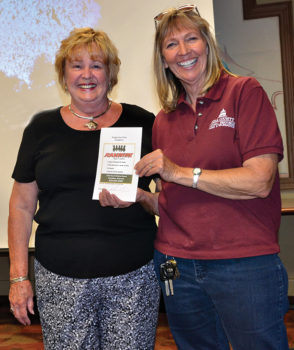
Speaker Sandy Reith (left) giving door prize for the month to Lois LaNassa; photo by Ed Skaff
Pam Boedeker
Bats were the topic of SaddleBrooke Nature Club’s last meeting of the season. Sandy Reith, the speaker, is with Pima County Natural Resources Parks and Recreation. She currently develops and delivers environmental education programs and leads hikes and nature walks in Pima County Parks.
Here in Arizona we have 28 species of bats. That ranks second with New Mexico placing number one. Worldwide there are 1300 species of bats. They compose 25% of all mammal species! Most live closer to the equator.
Bat species can range from the size of a thumb to some which have a six-foot wing span!
The vampire bats popular in movies are not in the United States. They are located in Mexico, Central and South America.
Only three tenths of one percent of bats contract rabies.
A bat with rabies usually appears lethargic; therefore, never touch a bat that is lying on the ground.
Notify Arizona Game and Fish Department for advice on getting rid of bats.
There are many reasons to embrace bats for more than Halloween decorations. 70% of bat species have a voracious appetite for insects, especially mosquitoes. (The Zika virus makes this especially relevant). Bats eat scorpions as well.
Bats are instrumental in dispersing seeds. They also play an important role in pollination.
Right here in Tucson we have a Mexican Free-Tail bat colony living under the bridge on Campbell Avenue! Nature Club members went there to see the bats’ nightly exit from under the bridge to fly out across the area and devour as many as a million tons of insects in one evening!
This particular roost is a maternity ward made up mostly nursing mothers and babies. Bats usually raise only one pup a year.
The cement bridge is an ideal place to raise young. It offers a stable warm temperature for the pups. It is not free of predators, however. Hawks have been seen waiting for the bats to exit at sunset. Owls find it easier to hunt bats on nights with a full moon. Bobcats, snakes and large centipedes also include bats in their diets.
That black-colored stuff on the ground under the bridge is bat guano. It is valuable as a fertilizer because it is high in nitrates. Bat droppings have even been used to make ammunition!
There are a couple SaddleBrooke Nature Club activities that are being planned for the summer months. Check the website for announcements www.SaddleBrookeNatureClub.com.
SaddleBrooke Nature Club meetings will begin again the second Monday of October (10) at 4:00 p.m. in the Coyote Room downstairs in the HOA 1 Clubhouse.
The program committee has already lined up some great topics and speakers for the fall. Watch for future articles about next season’s programs and fieldtrips.
